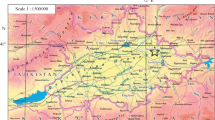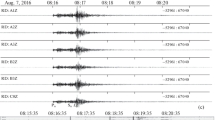Abstract
The article provides data confirming the theory of the meteoric origin of the South Caspian Basin, one of the largest reservoirs located in the arid climatic zone. The theory under consideration was first proposed by Edmund Halley (1656–1742). As a result of the disaster, the natural habitats of fauna and flora have changed far beyond the Caspian Sea. The arguments in favor of this hypothesis include not only the geological and geomorphological data of the ring structure of the area but also seismotectonic features. The analysis was based on IRIS seismic monitoring data for the period 1970–2019. Earthquake foci of magnitude M ≥ 3.5 form the boundary between the northern and southern parts of the Caspian Sea, which coincides with the direction of the deep faults of the Kavkaz–Kopetdag geological structure. On the territory of the South Caspian, most earthquake sources are located along the coastal part; they form a ring structure, and are confined to areas of neotectonic contrasts that coincide with the faults of the coastal zone of the Caspian. The central part of the South Caspian depression is aseismic. As a result of the asteroid impact, the central part was compressed, and fractured zones of seismogenic faults, which are permeable to the rise of deep fluids, formed around it.



Similar content being viewed by others
REFERENCES
Artyushkov, E.V., Formation of the south Caspian basin as a result of phase transitions in the lower continental crust, Dokl. Earth Sci., 2007, vol. 417, no. 1, pp. 1141–1146.
Bralover, T.J., Paul, C.K., and Leckie, R.M., The Cretaceous-Tertiary boundary cocktail: Chicxulub impact triggers margin collapse and extensive sediment gravity flows, Geology, 1997, vol. 26, no. 4, pp. 331–334.
Dadashev, F.G., Mamedova, P.A., and Poletaev, A.V., Zonal distribution of mud volcanoes in oil-gas bearing regions, Geol. Nefti Gaza, 2003, no. 1, pp. 18–20.
Fel’dman, V.I., Astroproblems—starry wounds of the Earth, Sorosovskii Obraz. Zh., 1999, no. 9, pp. 67–74.
Gevorkyan, S.G. and Golubov, B.N., The features of impact origin of the South Caspian basin, Planeta Zemlya, 2011, vol. 3, no. 1. pp. 132–139.
Idarmachev, Sh.G. and Magomedov, A.G., Present-day dynamic changes in the Caspian Sea level, Arid Ecosyst., 2016, vol. 6, no. 2, pp. 95–99.
Ivanova, T.P. and Trifonov, V.G., Seismotectonics and contemporary Caspian Sea level oscillations, Geotectonics, 2002, vol. 36, no. 2, pp. 109–123.
Kopnichev, Yu.F. and Sokolova, I.N., Ring seismicity in different depth ranges before large and great earthquakes in subduction zones, Dokl. Earth Sci., 2009, vol. 425, no. 2, pp. 448–450.
Kopnichev, Yu.F. and Sokolova, I.N., The ring structure of seismicity formed in continental areas before strong earthquakes with different focal mechanisms, Geofiz. Issled., 2013, no. 1, pp. 5–15.
Osipov, V.I., Physicochemical theory of effective tenses in ground, Geoekol., Inzh. Geol., Gidrogeol., Geokriol., 2013, no. 1, pp. 3–24.
Poletaeva, E.V., Analysis of regional breaks in the Caspian Sea according to the complex of geophysical data, Nauchn. Obozr., 2010, no. 1, pp. 3–8.
Rogozhin, E.A. and Platonova, S.G., Ochagovye zony sil’nykh zemlyatresenii Gornogo Altaya v golotsene (Focal Zones of Strong Earthquakes in Gorny Altai in Holocene), Moscow: Inst. Fiz. Zemli, Ross. Akad. Nauk, 2002.
Shikhalibeili, E.Sh., Gasanov, A.G., Tagiev, R.E., and Metaksa, Kh.P., New data on the structure and formation of the South Caspian basin, in Ocherki po geologii Azerbaidzhana: Dostizheniya geologicheskoi nauki Azerbaidzhana (Essays on the Geology of Azerbaijan: Achievements of the Geological Science of Azerbaijan), Baku, 1984, pp. 61–84.
Tapponnier, P. and Molnar, P., Active faulting and Cenozoic tectonics of the Tien Shan, Mongolia and Baikal regions, J. Geophys. Res.: Solid Earth, 1979, vol. 84, pp. 3425–3459.
Ulomov, V.I., A three-dimensional model of the lithosphere dynamics, seismicity structure, and variations in the Caspian Sea level, Izv., Phys. Solid Earth, 2003, vol. 39, no. 5, pp. 353–364.
Author information
Authors and Affiliations
Corresponding author
Ethics declarations
Conflict of interests. The authors declare that they have no conflicts of interest.
Statement on the welfare of humans or animals. This article does not contain any studies involving animals performed by any of the authors.
Rights and permissions
About this article
Cite this article
Idarmachev, S.G., Cherkashin, V.I. & Idarmachev, A.S. Genesis and Geoecological Changes of the South Caspian Depression after a Meteorite Fall. Arid Ecosyst 11, 274–278 (2021). https://doi.org/10.1134/S2079096121030082
Received:
Revised:
Accepted:
Published:
Issue Date:
DOI: https://doi.org/10.1134/S2079096121030082




